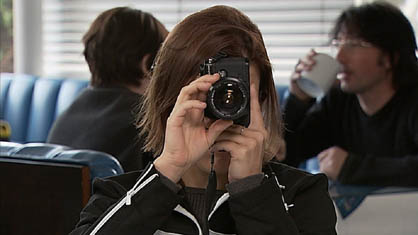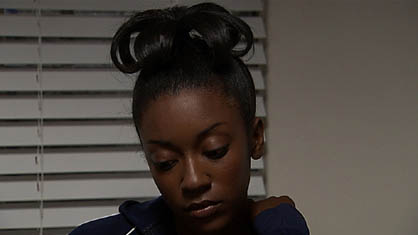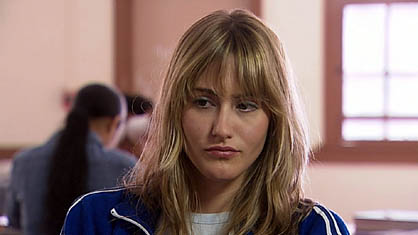|
|
| home > files |
| Twelve,
Barbara Kruger's Latest Work Federica Vannucchi, Sergio Mannino |
||||
| [in italiano] | The
contemporary city is strewn with messages, often anonymous, aimed at
more or less well-defined groups of people: most of these messages are
commercial in character, but some have a political or social content,
as expressions of protest, communications between gangs, etc. Since
the beginning of the eighties Barbara Kruger has created works that
are a combination of photography and words, and exhibited them in the
city by paying for spaces set aside for advertising. The urban context,
with its contrasts, its contradictions and distractions, is turned into
a container for art, the condition that allows this last to assume its
own content and its own form. This creates an interrelationship between
the artistic expression and the present, dynamic state of the city. |
[30oct2004] | ||
 Barbara Kruger's messages are easy to recognize by their graphics and content: the choice of colors and lettering and the use of black-and-white images have created an original and characteristic sign, and one which has not changed substantially over the last twenty years. Their purpose is to make us think about social and political questions, about the stereotypes and clichés created by our society. Consumerism (I shop therefore I am), conformity (Think like us, Look like us), politics (Hate like us), love (Thinking of you), and again Your body is a battleground, Love for sale, etc.: these are just a few of the slogans and themes on which the American artist has focused. Instead of the usual mix of images and graphics, Barbara Kruger's most recent work Twelve is a video installation presented at the Mary Boone Gallery in New York in March 2004. With the exception of the retrospective at the Whitney in 2000, it was the first time Kruger had exhibited in a New York gallery for six years. The work is located in a room and consists of the images of a video projected simultaneously on all four walls. There are twelve different stories, twelve dialogues set in a nondescript diner or private home. Each scene runs from six seconds to two minutes, and the whole thing lasts for about a quarter of an hour. It is performed by thirty-nine professional actors. The video is projected in a loop, so anyone entering the gallery is immediately caught up in the scene, without having to wait for it to start. There are no closing or opening credits: you are suddenly immersed in an apparently private conversation. Each scene involves two, three or four people, shot at half-length, talking to each other in an attempt to interact. Each of the actors occupies an entire wall; the empty space between them is presumably filled by the top of something, probably a table, at which the interlocutors are seated. Underneath the images words or short sentences, expressions that the artist defines as "fetished frenzies of news," (1) run rapidly on one or two lines. Despite your central position, you do not feel part of the scene: it seems rather as if it were not intended for you, as if you were an intruder on a private discussion.  The conversations turn on personal relationships –between couples, with children, among friends– and on more general and mundane themes. In particular, one of the scenes shows us a family of four eating their dinner. The wife scolds her husband for reading the newspaper at table, and at the same time argues heatedly with her children. In this fragment the artist looks at the delicate relationship between mother and daughter and, while the pair of them squabble over a trifle, the subtitles voice the thoughts of the mother ("Why did I have children?") and the daughter ("How can I avoid turning out like her?"). In another scene we find a couple trying to deal with a personal matter. At first he seems to be feeling guilty about something and asks her to forgive him. But as the argument proceeds and grows more intense, the apologies turn into accusations and the woman gives in to the harassment, displaying an attitude of resigned submission. Once again the subtitles convey the inner thoughts of the protagonists, such as the woman's "I hate myself when I'm with you." As we attempt to follow the scene it becomes obvious that there is no communication. The words fall like brief declarations, statements –often bawled– that do not necessarily imply a sense of relationship. The dialogue does not appear to be aimed at mutual understanding but is simply used to express a personal feeling of unease or a need for dominance. The space between the walls, stripped of what is needed for interaction, is flattened into the two-dimensions of the screen, as is evident in the four-way conversation over the merits of a woman artist, in which the people taking part in the discussion seem more interested in exposing the weaknesses and contradictions of each other's thinking than in putting across their own ideas. The images look like extracts from the daily newscast and the characters in the video seem to be imitating the television commentator. As Kruger herself explains, "[...] there will also be a running crawl on the bottom, like on CNN." (2) The constantly scrolling text describes what is going on in the characters' minds, superimposing itself on the words like a flow of thoughts reduced to simple and stark statements, fleeting moments, expressed in their most banal form and denying any individuality of the subject. In fact the expressions used seem to have been lifted from a common system and, given that they are being employed in a private conversation, appear to reduce the expressive originality of the individual. The diffusion of a generalized system of information in modern society has created and is continuing to develop a common language made up of simple signs that are immediately comprehensible. Out of this has come a sort of code that tends to make it easier for each individual to access services and information. Words like "PLAY," "REWIND," "SAVE" or "GAME OVER" are examples of signs in that code which are growing more and more common every day. Its circulation extends from the media to the ordinary language in which an interpersonal communication is couched, a common basis for understanding and exchange. In the moment of interaction differences and individualities are reduced, creating a depersonalization of the discussion itself that culminates in banality and the emptying of all meaning.  The media create what Baudrillard defines as the hyperreal, or more precisely, the simulacrum: the copy without the original. "It is no longer a question of imitation, nor duplication, nor even parody. It is a question of substituting the signs of the real for the real." (3) If the media are the means by which information is spread, the information is assimilated and modified by the media, creating a parallel reality. The message does not just alter our perception of the real, but even the perception that the individual has of him or herself. So personal vision is distorted by following a hyperreal parameter: "You are not yourself," as Barbara Kruger reminds us. It is interesting to note the ambiguous relationship that the artist has with the media: on the one hand her work sets out to criticize the medium, on the other it exploits it. In the eighties Barbara Kruger used the poster, and now she is using video, as if to underline the fact that art cannot fail to take into account the evolution of the system of communication and of the material instruments on which it relies. The choice of medium becomes a critical choice appropriate to the contingent moment. Coming up with a definition of art today is a complex question, given that a work can no longer be judged on its aesthetic value alone. "In the first half of the 20th century, and even earlier, throughout much of the 19th, critics and historians of art and architecture based their judgments of works and artists on an idea of Hegelian origin: Hegel contrasted the classical category of imitation of nature with that of the representation of an idea: the artist represents something that goes beyond his own individuality, an idea that transcends it and that to some extent belongs to a higher sphere." (4) Enzo Mari sees art as solace in the face of two great mysteries: the concept of infinity and the concept of nothingness: "religions solve these problems with acts of faith, but in concrete terms the absurdity of this condition remains, along with the fact that the only dignity, the only comfort in this emptiness is provided by the odd poem, the odd work of art [...] which makes us capable of living with a nightmare [...]. This is what I mean by the concept of the realization of a total work, one that can open itself up to the yearning for life." And he goes on to say, "striving for the total form corresponds to the desire to represent what is implicit in God, independently of his presence or absence." (5)  Many artists have tried to represent the mystery of existence, of creation, death, love, etc. We are thinking of Francesco Clemente, with his bodies locked in impossible embraces, enormous genitals, wombs and mouths that hold inexplicable stories; we are thinking of Enzo Cucchi, Dan Flavin and many others. We are thinking of Sottsass's architecture or furniture, the metaphysical works of Aldo Rossi or the silent ones of Louis Kahn. We are thinking too of Vanessa Beecroft, who seeks in her performances to capture some of the mystery that lies behind people, in other words to grasp the aura that is hidden in each of us and that is inevitably left out of representations on paper or canvas. But there are artists who have gone down another path, who have strayed into territories that have not been wholly explored; artists who hold that art has above all a social value, that it serves to change the world or at least to make us reflect on its injustices or contradictions. Judith Malina and Hanon Reznikov of the Living Theatre say that "our civilization is probably 6000 years old and if you think of people being able to live 100 years, that's no more than the lifetime of 60 people, one born the day after another died. So it's a very young civilization and we still have a lot to learn to make it work better. There is still hope." (6) "The Theatre has a social function and, as an art form, should fight to make the world better." (7) Barbara Kruger is undoubtedly one of the artists who is venturing down this road, and we don't know where it will take her. We don't know what will become of these works in 100 or 500 years, even supposing this to be of any importance. We don't know whether anyone will remember them, or if it will be possible to understand them in the same way as today. Like every road whose destination is unknown, it's a risky one, but it is an attempt, and in our view a conscious and profound one. In part because, among other things, it is an attempt to represent that brief and fleeting instant that is the present. Federica Vannucchi fedearc@yahoo.com Sergio Mannino sergiomannino@hotmail.com |
||||
| English translation by Huw Evans. Pictures from Barbara Kruger, Twelve. Installation view, Mary Boone Gallery, New York, March 2004. | ||||
| NOTES: 1. "Transcript of Barbara Kruger interview with Tom Doig", in Voiceworks, (Melbourne-Sidney), no. 56, January 20, 2004. 2. Ibidem. 3. Jean Beaudrillard, Simulacra and Simulation, Semiotext[e], New York 1983, p. 4. 4. Cesare Birignani, "Su Gianluca Milesi (ed altre questioni della blob architecture)," in ARCH'IT extended play, 2001. 5. Enzo Mari, La valigia senza manico, Bollati Boringhieri Editrice, Turin 2004, p. 39. 6. Interview with Judith Malina and Hanon Reznikov of the Living Theatre, conducted by Giovanna Landi, New York, May 14, 2004. 7. Ibidem. |
||||
| Federica
Vannucchi (Prato, 1973) is a graduate of Architecture from the University
of Florence under the chair of prof. Alberto Breschi. She takes part
in several competitions and is a recipient of the Second Prize for the
"Biennale dei Giovani". She is presently practicing with Eisenman Architects
in New York City where she participated in the City of Culture in Santiago
de Compostela and the Holocaust Memorial in Berlin. Sergio Mannino <www.sergiomannino.it> (Florence, 1969) graduated in Architecture from the University of Florence under the direction of Ettore Sottsass and Remo Buti. He collaborated for 3 years with professor Remo Buti during wich time he had the opportunity to study furniture design and interior architecture in depth. He designed projects for architecture and design competitions and, with his partner Lucia Gori, won the "Concorso di idee per il recupero dell'Area Ex-Longinotti, Firenze" in 2000. In September 2002 he mounted a one-man show of his furniture designs, including 9 built-pieces and 100 watercolors, at the Memphis-Postdesign Gallery in Milan. At present Sergio Mannino lives in New York, where he works as an architect, with a special interest in the sensory aspect of design and in the study of the urban structural changes that result from the co-existence of different cultures and traditions. |
||||